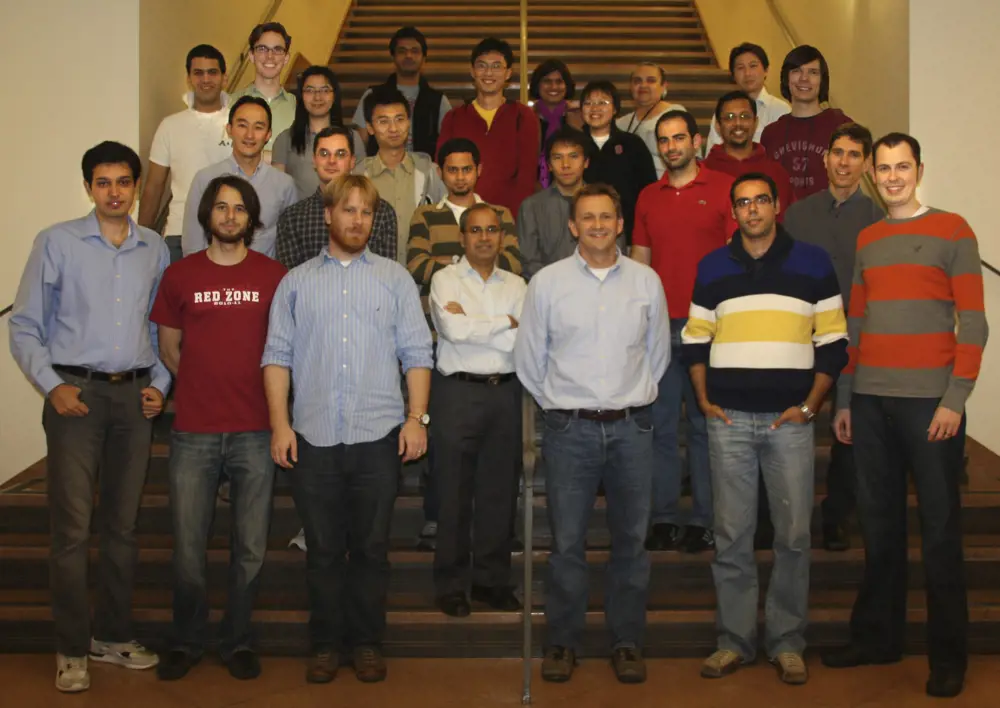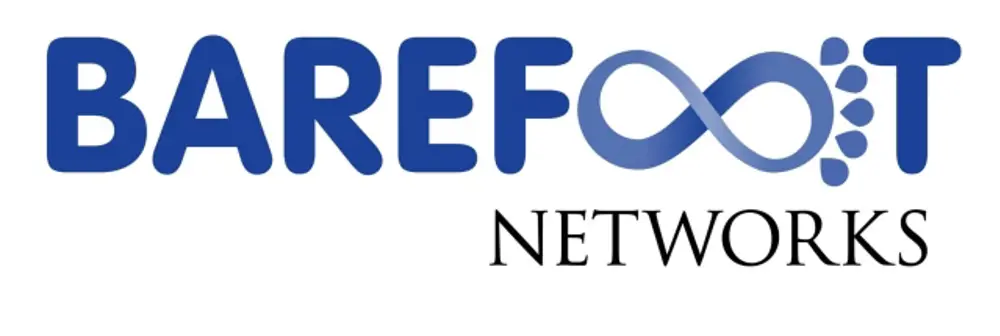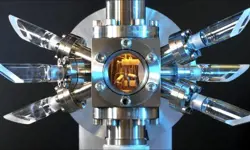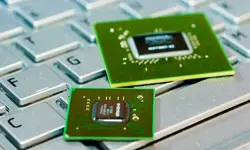
Evolving the internet
It would be hard to think of anyone more appropriate to interview over an internet link between Sussex and California than Professor Nick McKeown FREng. After all, his PhD research findings delivered a tenfold increase in the speed of routers, which enabled the internet to handle the traffic created by Skype and other services.
HP decided to focus McKeown’s time and research resources on internet router architecture, which quickly became one of the hottest areas of technology
Back in the 1980s, McKeown was assigned his first research tasks at the Hewlett Packard (HP) Labs near Bristol. At the time, he hoped to work on artificial intelligence or computer architecture, the popular topics of the day. However, HP decided to focus McKeown’s time and research resources on internet router architecture, which quickly became one of the hottest areas of technology. This was before the advent of the World Wide Web and before most people had heard of the internet, when network connections were mostly between a scattering of big computers in large organisations. Since that fateful HP decision, McKeown has been at the cutting edge of research into the architecture of networks rather than computers.
Mind made up
Although McKeown did what he was told by his new employers, this had not always been the case. Had he heeded his careers master at school, he would have dismissed engineering altogether. When McKeown let on that he was considering an engineering education, inspired in part by his father, Professor Pat McKeown FREng, an engineer and entrepreneur, he recalls that the careers master’s response was: “You are too smart to be an engineer. You should go into something creative.” McKeown laughs and says: “From that moment my mind was made up. I decided: ‘Right, I am going to be an engineer!’
From that moment my mind was made up. I decided: ‘Right, I am going to be an engineer!’
McKeown, now Professor of Electrical Engineering and Computer Science at Stanford University, delights in relating this anecdote, and how it left a lasting impression. He ensures that he creates links with schools, including his old one near Bedford, Wootton Upper School, helping to ensure that future generations do not encounter similar ignorance about the importance of engineers, and the creativity involved in engineering.
One way in which he does this is by hosting a course for school students based on the teaching methods developed at Stanford. Four students from his old school in Bedfordshire joined a class of 100 or so in Istanbul. Here, McKeown and colleagues teach high-school students from Turkey and the UK how to program in Java, as an introduction to the field of ‘computer science’. McKeown prefers this term to ‘ICT’ or ‘IT’ which he feels are associated with the maintenance and administration of computers and networks rather than software development, creation and programming. He says “These are necessary roles but they differ greatly from the engineering discipline of computer science. It is the equivalent to referring to a mechanical engineer as a mechanic!”

Professor McKeown directs a programme in Istanbul that teaches Turkish high school students the fundamentals of computer science. The primary purpose is to give rising high school juniors, especially girls, their first experiences of programming © Asena Gencel
McKeown’s own journey to California, and into computer networking, was not straightforward. He initially went to Durham University to do a degree in mechanical engineering. However, he found Durham very old fashioned and “a bit out of date from an engineering point of view”. So he left after a year, to go to Leeds “to swim with Adrian Moorhouse”, who went on to win a gold medal in the Seoul Olympics in 1988. McKeown himself narrowly missed being in the UK’s Olympic swimming team in 1984. “There were just too many good breaststroke swimmers in the UK at the time.”
Leeds wasn’t just about swimming though. Armed with a scholarship from GEC-Marconi, topped up a year later with a British National Engineering Scholarship, McKeown studied for a degree in electrical and electronic engineering.
On graduating in 1986, McKeown joined HP Labs in Bristol. At that time, a PhD was not essential to get a job in research in the UK. Everyone at HP’s main R&D centre, in Palo Alto, California had to have a PhD, but there were not enough people in the UK with engineering PhDs. “So they took a load of us fresh out of our undergraduate degrees. I came to realise later how little I knew. They gave us this very expensive, well-funded education, paid us a salary, allowed us to make lots of mistakes, build stuff. It was an incredible apprenticeship.”
I came to realise later how little I knew. They gave us this very expensive, well-funded education, paid us a salary, allowed us to make lots of mistakes, build stuff. It was an incredible apprenticeship
This thought sets McKeown reflecting on the state of the UK at that time. HP’s recruitment problems were, he says, “a very sad reflection of the awful state of engineering and engineering education.” At that time, he says, the government’s view was that there was no future in technology and no one cared about manufacturing. This explained why, as McKeown recalls it, when he graduated, the most popular career for electrical engineering graduates was accounting, followed by chartered surveying. Engineering came third.
West Coast creativity
For an aspiring engineering researcher, the US certainly looked more attractive, especially for someone whose work exposed him to the excitement of California and its burgeoning high technology sector.
It was McKeown's masters research at the University of California at Berkeley and then his PhD work that shook up thinking on computer networks. The official title of his PhD project was Scheduling Cells in an Input-Queued Cell Switch, but what it really meant, McKeown explains, was how to make switches and routers go faster. It began with the masters course when, with three fellow masters students, he built "the world's fastes router", 10 times faster than anything that had gone before. They called their system Bay Bridge and took it to Cisco Systems.
However, it wasn't speed that mattered to Cisco at the time, so much as adding new features to its router boxes. This was three years before the first web browser, Mosaic, and only shortly after the industry had settled on the best protocol, TCP/IP, to coordinate the data traffic between systems.
The early work on routers was all about the algorithms that control the packets of data that the hardware has to process and ensure that they get to the right place in the right order. After Bay Bridge came Tiny- Tera, which McKeown says "was our attempt to see how you could build a one-terabit per second switch out of semiconductor technology. That seemed like a very high speed at the time. It needed specific algorithms for scheduling packets." Those scheduling algorithms were at the heart of his PhD.
The networking industry eventually cottoned on. After completing his PhD in 1995, McKeown joined Cisco Systems for a few months before moving to become a professor at Stanford University. At Cisco he "helped architect", as he describes it, the gigabit switched router (GSR), that became Cisco's flagship router.
McKeown's portfolio in innovations went on to change the networking business. Tiny-Tera gave birth to a spin- out company, Abrizio, which made chips for switching hardware. It was set up with venture funding in 1997, while McKeown took time off from Stanford and then, two years later, PMC-Sierra bought the company.
I couldn't have predicted what would happen after that, through the rest of the 90s, but I realised that this was huge. I spent the next 10 years on algorithms, techniques, architectures, designs, chips for making switches and routers faster
Those were heady days in Silicon Valley. McKeown was, as he puts it, in the right place at the right time. A key event was when he saw the Mosaic web browser. "I couldn't have predicted what would happen after that, through the rest of the 90s, but I realised that this was huge. I spent the next 10 years on algorithms, techniques, architectures, designs, chips for making switches and routers faster."
Cheaper chips
One of those developments came as a surprise to the makers of expensive static RAM (SRAM) chips. Dynamic RAM (DRAM) chips of the sort used in PCs are inexpensive, high-volume devices, but they have limitations. The physical dimensions of DRAM chips were great for making cheap chips, but they limited the speeds switches and routers could handle as data packets came and went.
“As a network gets faster, you need faster and faster memories in order to buffer these packets,” says McKeown. It got to a stage where packets were arriving faster than the chips could handle them. So router makers went for faster SRAM technology, even though SRAM chips were 75 times more expensive per bit than DRAMs. “The networking industry was using about $500 million per year of SRAMs. And they were too small, too expensive, too power-hungry.”
Cue McKeown, with his algorithms: “We figured out a way that, with a clever algorithm and a one-page proof, you could use a DRAM with this short algorithm sitting in front of it and you couldn’t tell the difference between it and the SRAM that it would replace.”
As with Abrizio, McKeown set up another business to help to transfer the technology from the university into commercial use. There was more to the idea than just algorithms: it needed chips, designed to work those algorithms. In 2003, along with one of his PhD students, he set up Nemo Systems, another chip development business, this time making DRAM chips for networking systems. Once again, within two years, the fledgling business changed hands, when Cisco acquired it.
McKeown’s early days are littered with patent applications that went on to earn Stanford and Berkeley millions of dollars. However, he brought that flow of patents to an end in 1999. “I don’t patent anything now. I put everything into the public domain, all of the software, all the ideas, all the algorithms.”
This reflects McKeown’s views on the role of research in universities. “I strongly believe that, as engineering researchers, we are supposed to be working in the service of, not only industry, but the engineering community as a whole.” This means that academics shouldn’t come so close to industry that they end up thinking too short-term. His strategy now is to cut ideas that get rave reviews in industry.
The best ideas have been the ones where we have hit a raw nerve and our colleagues have gone bright red and hated the idea. In my experience, these have proved the most game-changing ideas of all

The McKeown Group 2010. Part of the Department of Computer Science at Stanford University, the group works on projects that shape the way the internet works in conjunction with the Clean Slate Program
“I make a deal with my PhD students,” he explains. “After we work on a new research idea for six months, we go tell our colleagues in the networking industry what we are doing. If they love what we are doing I cancel the project immediately! We offer our industry colleagues to take it on themselves – after all, they have way more resources than we do.”
Instead, he likes to take on projects that are counter-intuitive and challenge conventional thinking. “If our industry colleagues look puzzled, then perhaps we’re onto something – or maybe we are crazy! The best ideas have been the ones where we have hit a raw nerve and our colleagues have gone bright red and hated the idea. In my experience, these have proved the most game-changing ideas of all.”
If industry ponders on the idea and promises to think about it, then McKeown’s group might take it further. But “if they go bright red and hate it and we think it’s a good idea”, then the researchers really throw themselves behind it. “This means that it is something that is changing the way that the industry thinks.” He emphasises that this obviously does not apply to all areas of engineering, but it does with today’s networking.
Clean slate
In the mid-2000s, McKeown experienced what he calls his mid-career crisis. “I became so frustrated by the networking industry. I was able to have an impact on the way that switches and routers were designed, but I couldn’t see a way to have an impact on the way that the internet was architected. There was no point in doing the research. We could publish all the papers that we wanted, but the networking industry was not listening. It was making huge profits by preventing new ideas from taking root; it built a strong barrier to entry for new ideas.”
McKeown took his frustrations to Stanford’s Dean of Engineering, intending to resign. “As I was leaving, he said, ‘Okay, you are over 40 now. When you are below 40, you can complain about the older crowd, saying that it is all their fault and they are holding things back. Once you get past 40, you are the older crowd. It is your job to fix it.’” McKeown says this was “the best piece of advice I ever received”. So he didn’t follow through with his threatened departure. He does, though, admit to feeling dispirited for a few months. Then he threw himself into “a research programme with arrogant hubris”. In the Clean Slate Program, his Stanford team set out “to explore what kind of internet we would design if we were to start with a clean slate and 20-30 years of hindsight.”
When you are below 40, you can complain about the older crowd, saying that it is all their fault and they are holding things back. Once you get past 40, you are the older crowd. It is your job to fix it
One outcome of Clean Slate was to clarify the concept of software-defined networking (SDN). The development of SDN came about from Martin Casado’s PhD work. He was a PhD student within the group working closely with McKeown and Scott Shenker – a professor at Berkeley. With SDN, operators don’t have to rely on systems built around custom chips and hardware-specific software; instead, network engineers can build cheaper networks that are easier to manage, while at the same time offering increasingly sophisticated functionality. The operators, rather than the box-makers, can decide what services customers get.
McKeown’s group saw SDN as a way to “open up the internet infrastructure for innovation”. SDN does for networking what commodity chips and separating software from machine making did for the computer industry. McKeown has described SDN as “the biggest change to networking in 25 years”. As he sees it: “What SDN really means is disaggregation, the breaking apart of this vertically integrated model”.
“The networking industry, of course, hated this and fought very hard.” After all, McKeown wasn’t just talking technology. “It was not simply a technical question, it was a business question. The industry had aligned itself in the vertically integrated model to prevent those who own and operate networks from moving forwards.”
McKeown’s group saw SDN as a way to “open up the internet infrastructure for innovation”
Network suppliers may not have liked the idea, but it went down well in other circles. In 2007, McKeown, Schenker and Casado formed Nicira, a company that built the software needed for companies to make their networks software-defined—and allowed the networks to be virtualised.
At this time, Google, Amazon, Facebook and other organisations were tearing up the old rule books. These businesses, says McKeown, have revolutionised how we think about building computer infrastructure, storage and networking. All this fed the appetite for something like SDN. “It captured the imagination of people. SDN has overturned the industry.” While the Nicira software was partially co-developed with Google early on, it was also a huge benefit to smaller companies that wanted the benefits of SDN, but did not have enough engineers to develop their own software, like Google, Amazon and other large-scale tech companies could.
In 2012, VMware acquired Nicira for $1.26 billion, and the SDN software developed by Nicira is a profitable and rapidly growing part of VMware’s business. An industry report by SDxCentral estimates that the SDN business may be worth $35 billion by 2018. It has spawned dozens of start-ups in Silicon Valley alone. Maybe it is partly responsible for all that traffic on Route 101, McKeown’s own informal indicator of the state of the local high-tech economy. “The route gets busier during these times of boom.”
Career timeline and distinctions
Born, 1963. BSc Electrical Engineering, University of Leeds, 1986. Network and communications research group, Hewlett-Packard Labs, 1986-1989. MSc, 1992 and PhD, 1995, University of California at Berkeley. Architect of GSR 12000 router, Cisco Systems, 1995. Assistant professor of electrical engineering and computer science, Stanford University, 1995. Co-founder and CTO, Abrizio Inc, 1997. Associate professor of electrical engineering and computer science, Stanford University, 2002. Co-founder and CEO of Nemo Systems, 2003. Elected Fellow of the Royal Academy of Engineering, 2004. Elected Fellow of the IEEE, 2005.Faculty director of the Clean Slate Program, University of Stanford, 2006. Co-founder of Nicira Networks, 2007. Full professor at Stanford in 2010. Elected to the US National Academy of Engineering, 2011. Co-founder of the Open Networking Lab, 2011. Co-founder of Barefoot Networks, 2013.
Building chips
McKeown is a part of this trend. When he isn’t at Stanford, or teaching teenagers in Turkey, or supporting another of his passions, “trying to abolish the death penalty” in California and the US, he spends time at Barefoot Networks. The company, his fourth start-up business, began operating in 2013 “in stealth mode”. It hasn’t said what it does, but what McKeown will say is that it is “building chips and will define a whole new way to program switches and routers, using a language called ‘P4’.” Why another business? “To ensure that networks and programmable all the way down to the wire. The $50-$100 million it takes to build a chip is beyond the reach of a university. You have to do that in a commercial setting. The idea is to get the idea out there and transfer it.”

Not much is known about McKeown’s enigmatic new company but web links show that: “Barefoot Networks is a start-up founded in 2013 by industry veterans. We are operating in stealth mode, so we cannot share much about our product plans. Weare currently looking for smart, multi-disciplinary engineers … to help us make networks, including the data plane, programmable.”
This brings us back to McKeown’s philosophy: “I have looked for the right balance of being able to provide ideas, but always provide them for free, and think of it as a technology transfer process. If my students or I want to participate in it, we can do so, not as a way of making money, but as a way of helping the industry as a whole.”
SDN is another revolution in technology. “There is a lot of interest and excitement in infrastructure again, technically, from a business point of view and an investment point of view. I tell my students that networking has got sexy again.” Quite an achievement for someone who nearly abandoned the business because, until a decade ago, he thought that networking was dull and stuck in a rut.
***
This article has been adapted from "Evolving the internet", which originally appeared in the print edition of Ingenia 64 (September 2015).
Contributors
Michael Kenward OBE
Author
Keep up-to-date with Ingenia for free
SubscribeRelated content
Software & computer science

Pushing the barriers to model complex processes
In 2007, Imperial College London spinout Process Systems Enterprise Ltd won the MacRobert Award for its gPROMS (general-purpose PROcess Modelling System) software. Costas Pantelides and Mark Matzopoulos, two of the key people behind the success of gPROMS, tell how they created a way in which engineers can harness physics, chemistry and engineering knowledge within a framework that solves highly complex mathematical problems.

Compact atomic clocks
Over the last five decades, the passage of time has been defined by room-sized atomic clocks that are now stable to one second in 100 million years. Experts from the Time and Frequency Group and the past president of the Institute of Physics describe a new generation of miniature atomic clocks that promise the next revolution in timekeeping.

The rise and rise of GPUs
The technology used to bring 3D video games to the personal computer and to the mobile phone is to take on more computing duties. How have UK companies such as ARM and ImaginationTechnologies contributed to the movement?

EU clarifies the European parameters of data protection
The European Union’s General Data Protection Regulation, due for adoption this year, is intended to harmonise data protection laws across the EU. What are the engineering implications and legal ramifications of the new regulatory regime?
Other content from Ingenia
Quick read

- Environment & sustainability
- Opinion
A young engineer’s perspective on the good, the bad and the ugly of COP27

- Environment & sustainability
- Issue 95
How do we pay for net zero technologies?
Quick read

- Transport
- Mechanical
- How I got here
Electrifying trains and STEMAZING outreach

- Civil & structural
- Environment & sustainability
- Issue 95